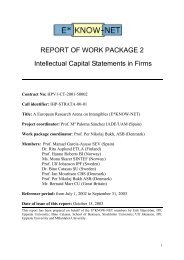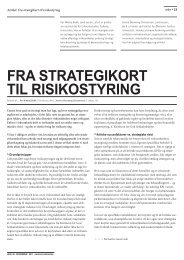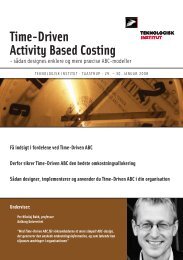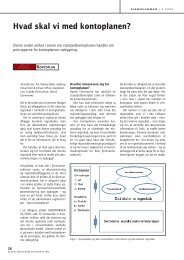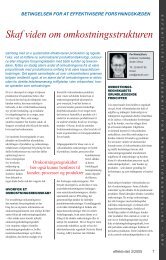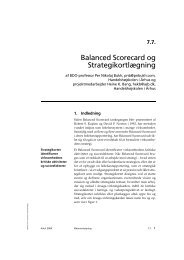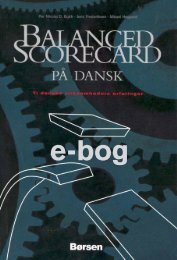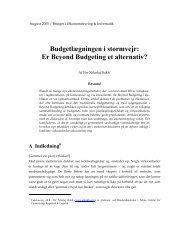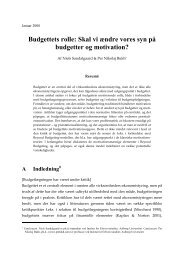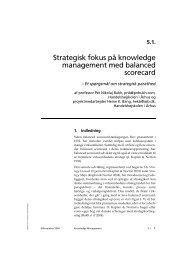guidelines for managing and reporting on intangibles (intellectual
guidelines for managing and reporting on intangibles (intellectual
guidelines for managing and reporting on intangibles (intellectual
You also want an ePaper? Increase the reach of your titles
YUMPU automatically turns print PDFs into web optimized ePapers that Google loves.
Figure 3. A breakdown of <strong>intangibles</strong> – a first example.<br />
PROCESSES<br />
EXAMPLE<br />
Strategic<br />
Objective<br />
Increase Market Share<br />
Critical<br />
Intangibles<br />
Maintain <str<strong>on</strong>g>and</str<strong>on</strong>g> attract<br />
key employees<br />
Innovative<br />
capacity<br />
Customer<br />
approach<br />
Intangible resources<br />
to create or develop<br />
Highly trained<br />
people<br />
Patents<br />
Loyal customers<br />
Intangible activities<br />
to improve resources<br />
Training<br />
activities<br />
R&D<br />
activities<br />
Direct<br />
marketing<br />
Intangible activities<br />
to assess results<br />
Employee<br />
Survey<br />
Analysis ofR&D<br />
rate of return<br />
Customer<br />
Survey<br />
However, practical reality may be more complex, <str<strong>on</strong>g>and</str<strong>on</strong>g> a wide range of activities <str<strong>on</strong>g>and</str<strong>on</strong>g><br />
resources might affect each critical intangible. For example, as shown in Figure 4, an<br />
important intangible resource that may affect the three critical <strong>intangibles</strong> is flexibility.<br />
In order to increase this resource, the company can either increase job rotati<strong>on</strong> (acting<br />
thus <strong>on</strong> its human capital), or better codify the routines that allow fast socializati<strong>on</strong> of<br />
new employees (acting <strong>on</strong> structural capital), or develop a set of customer profiles each<br />
of which tied to a specific set of acti<strong>on</strong>s (acting <strong>on</strong> relati<strong>on</strong>al capital). At the same time,<br />
an increase in job rotati<strong>on</strong> may increase the need <str<strong>on</strong>g>for</str<strong>on</strong>g> codificati<strong>on</strong> routines thus creating<br />
a closer relati<strong>on</strong>ship between human <str<strong>on</strong>g>and</str<strong>on</strong>g> structural capital, but may negatively affect<br />
employee satisfacti<strong>on</strong> <str<strong>on</strong>g>and</str<strong>on</strong>g>, c<strong>on</strong>sequently, decrease an individuals’ interest in learning<br />
<str<strong>on</strong>g>and</str<strong>on</strong>g> further development.<br />
In many cases, the firm does not know exactly what the precise impact of each activity<br />
<strong>on</strong> the resource will be, but a reas<strong>on</strong>able estimati<strong>on</strong> can be made based <strong>on</strong> past<br />
experience.<br />
In order to better assess causality between acti<strong>on</strong>s <str<strong>on</strong>g>and</str<strong>on</strong>g> results, a final set of activities<br />
needs to be developed. Assessment of results is crucial as it defines the organisati<strong>on</strong>’s<br />
ability to learn from its acti<strong>on</strong>s <str<strong>on</strong>g>and</str<strong>on</strong>g> to improve c<strong>on</strong>tinuously <strong>on</strong> them. Its result is the<br />
creati<strong>on</strong> of routines that increase <strong>intellectual</strong> capital permanently. We will come back to<br />
these latter types of activities when analysing the 3 rd phase.<br />
16



